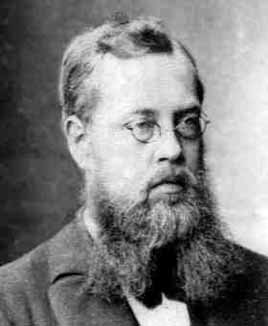 |
| Click to see a larger version |
My life is actually quite incomprehensible for me. As a young man, I had no idea that I was blessed with originality. Then, as a 26-year-old, I suddenly realized that I could create. I read a little and began to produce. In these years, 1869-1874, I had a lot of ideas which, in the course of time, I had developed only very imperfectly.
In particular, it was group theory and its great importance for the differential equations which interested me. But publications in this area went woefully slow. I could not structure it properly, and I was always afraid of making mistakes. Not the small inessential mistakes... No, it was the deep-rooted errors I feared. I am glad that my group theory in its present state doesn't contain any fundamental errors.
S. Lie
Sophus Lie was born on December 17, 1842, in Nordfjordeid in Middle-Norway, where his farther was a protestant minister. He did equally well in all subjects and did not demonstrate any particular preference for mathematics while studying.
Sophus Lie was taught mathematics at school by Ludvig Sylow and then attended Sylow's lectures on group theory at the University of Christiania from where he graduated in 1865 (not gaining a distinction). There followed a few years when he could not decide what career to follow. Maybe this was the reason that algebraic problems were at first alien to Lie and as was believed by his pupil Gerhard Kowalewski, Lie did not even seem to be particularly familiar with his famous countryman Abel's theories.
A turning point came in 1868 when he read papers on geometry by Poncelet and Plucker. In 1869 Lie went to Berlin where he met and became friends with Felix Klein. They met again in Paris, where Jordan drew their attention to Galois' theory. The two friends started to work on transformation groups. This collaboration resulted in the publishing of several papers. Later in 1872 their joint work had as one of its outcomes Klein's characterisation of geometry (Erlanger Programm) as properties invariant under a group action. While in Paris Lie discovered contact transformations. These transformations allowed a 1-1 correspondence between lines and spheres in such a way that tangent spheres corresponded to intersecting lines.
Because of the French-German war of 1870 both Klein and Lie left France, Lie deciding to go to Italy. On the way however he was arrested as a German spy and his mathematics notes were assumed to be coded messages. Only after the intervention of Darboux was Lie released and he decided to return to Christiania. In 1871 Lie became an assistant at Christiania (which became Kristiania and then Oslo in 1925) and obtained his doctorate.
Lie had started examining partial differential equations, hoping that he could find a theory which was analogous to Galois' theory of equations. He applied his contact transformations to extend a method due to Jacobi of generating further solutions from a particular set. This led Lie to define what he called a continuous transformation group, but which is not a group according to our definition, rather what is today called a Lie algebra.
At this point he left his original intention of examining partial differential equations and examined Lie algebras. Killing was to examine Lie algebras quite independently of Lie, and Cartan was to publish the classification of semisimple Lie algebras in 1900.
After being elected a member of the Science Society of Christiania and granted personal professorship Lie worked at the Christiania University. However he did not have any students or colleagues who were interested in his work. Thus Klein and Mayer, understanding Lie's difficult situation, sent their student, Friedrich Engel, on a mission to study under Lie and to assist him in preparation of his large unpublished theory. Lie collaborated with him for nine years after which they jointly published Theorie der Transformationsgruppen in three volumes in 1893. This was Lie's major work on continuous groups of transformations.
In 1886 Lie succeeded Klein in the chair of mathematics at Leipzig with Engel as his assistant. There he managed to establish a school devoted to the study of continuous group approach to differential equations and differential geometry. Unfortunately his work was overshadowed by his illness. Lie suffered from pernicious anaemia. Probably for reasons connected with his illness, in 1892 Lie severed most of his personal contacts in Germany, including his close relationship with Engel. His lifelong friendship with Klein also broke down and the following year Lie publically attacked Klein saying
I am no student of Klein and neither is the opposite the case, though the latter might be nearer to the truth.
Lie returned to Kristiania in 1898 to take up a post specially created for him but his health was already deteriorating and he died soon after taking up the post, on February 18, 1899. His memory was honoured at a special meeting of the Science Society of Christiania by his teacher Sylow and later on at a plenary meeting of the Royal Saxon Society by his student Engel. Lie was buried at Our Saviour's Cemetery at Christiania (Oslo).
Some photos related to Sophus Lie see here.